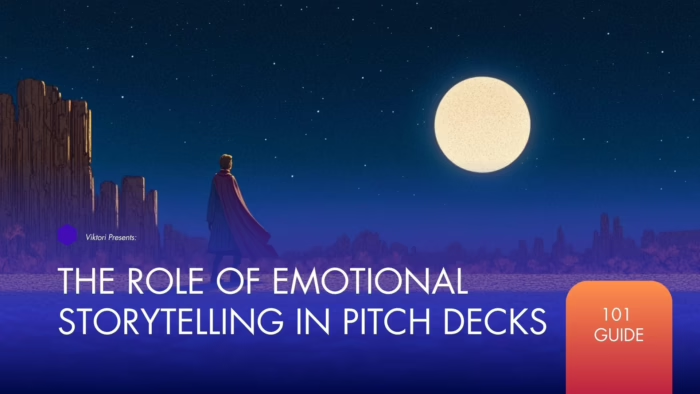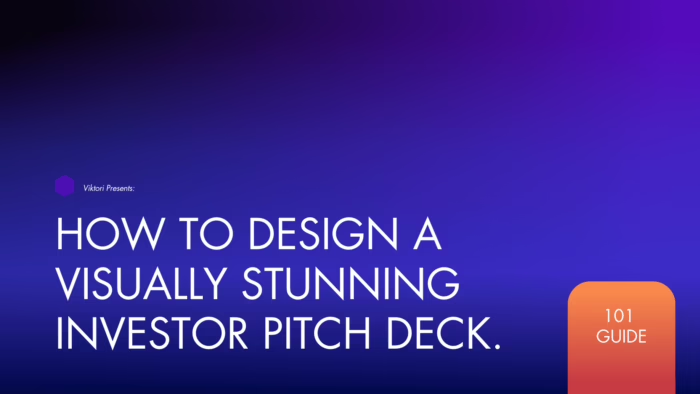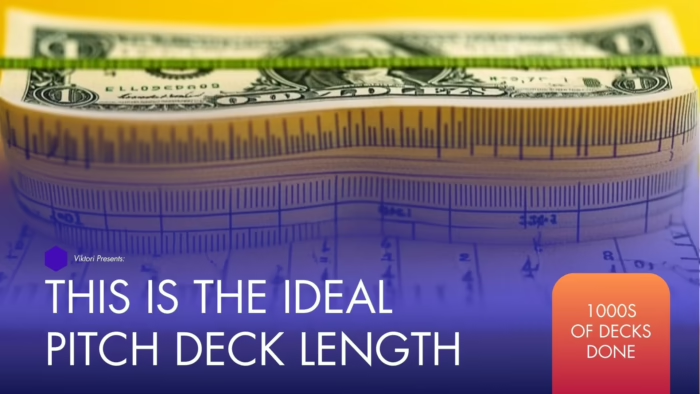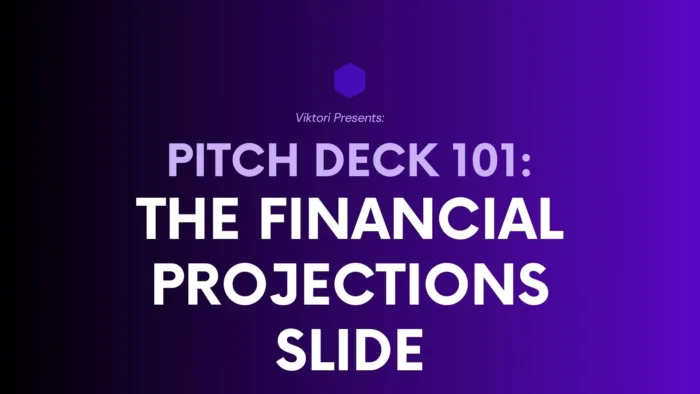You’ve got a game-changing business idea that’s going to shake up international trade, but let’s face it, your pitch deck? Well, it’s about as exciting as watching paint dry in slow motion. Ouch. But don’t sweat it, because I’m here to turn that snoozer into a blockbuster pitch deck that’ll have investors throwing money at you faster than you can say “global domination.”
I’m Viktor, a pitch deck expert and creative business strategist. Over the past 13 years, I’ve helped businesses secure millions of $ in funding thanks to my approach and I’m sharing it here in this pitch deck guide.
And yeah, I’ve had my share of ideas that were a bit too hot for the big leagues, but that’s just part of the fun.
Stick with me, and I’ll show you how to craft a trade pitch deck that’ll capture hearts, minds, and wallets. Ready to get those international markets eating out of your hand? Let’s roll up our sleeves and dive into the nitty-gritty.
Get My 12 Slide Framework That Got $500mil in Funding For Clients.
What do you think of having 12 dead simple formulas, that will help you craft 12 slides, in about 1 hour? That’s what you’ll get, when you download my 12 slide framework. Save hours crafting your pitch deck copy with my tested approach that includes:
- Elevator pitch one sentence formula
- Problem/ solution slide one sentence formula
- Competitor slide one sentence formula
- 9 other formulas, tips, tricks and advice
The formulas worked for 40+ industries and 500+ companies. Including the one you’re looking at now.
Clicking the link won’t charge you anything.
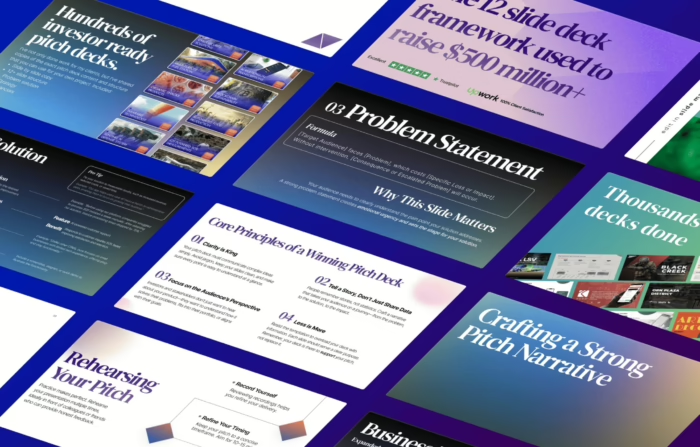
Get an investor ready pitch deck that gets you funded and saves over 30 hours of your time.
Join 100s of successful entrepreneurs who’ve transformed their pitch decks by using my hands-off approach, which includes: market research, copy, design, financials, narrative and strategy.
1 week turnaround time and less. Special pricing for early stage companies.
The least you will get on this call is 10 actionable tips & strategies to own that next pitch, worth $599, for free.

14 Slide Trade Pitch Deck Template | Google Slides
Want a similar template for your pitch? Book a call free below to discuss more, or reach out through email.
The above is is just a simplified pitch deck version developed as part of our entrepreneurship program for graduate studies.
Founders that are serious about getting the funding they need, opt in for a deck has industry specific content, superb narrative and award winning design like these ones below:









I can help you build that deck with my hands-off process in 7 days or less.
Book a free 30 minute call below if you’re serious about getting an investor ready deck, and we’ll discuss your needs in detail. I’ll help you design the deck, write the content, develop the narrative and flesh out the strategy with financials.

We help 15,000+ founders every month create better pitch decks.
Alternatively, get the custom template for just $69,99.As soon as the payment is processed I’ll send over a quick questionnaire and deliver the deck in 24 hours and less.

Follow us on social for the newest templates:
Creating a detailed trade pitch deck involves strategically structuring your content to convey your business’s value proposition, market opportunity, and competitive advantage in a compelling way. Here’s a detailed outline tailored for a trade-focused startup looking to make a strong impression on potential investors:
1. Cover Slide
- Company Name and Logo: Positioned prominently to ensure brand recognition.
- Tagline: A powerful, succinct statement that captures the essence of your business, such as “Revolutionizing Global Trade, One Transaction at a Time.”
- Presenter’s Name and Contact Information: Clearly displayed to establish a personal connection and provide an easy way for investors to follow up.
Design Tip: Keep it clean and professional, with your logo and company name as the focal points. Use your brand colors for consistency.
2. Introduction
- Mission Statement: “To streamline international trade for small and medium-sized enterprises (SMEs) by eliminating bureaucratic overhead and simplifying logistics.”
- Vision Statement: “Envisioning a world where borders are no barriers to business, empowering every entrepreneur with the tools for global success.”
Content Strategy: This slide sets the tone. It’s your elevator pitch in slide form. Use compelling imagery or icons that reflect global connectivity and trade. Ensure the mission and vision are not just statements but narratives that invite the audience into your world.
3. The Problem
- Problem Identification: Start with a bold statement or question, such as “Why should international trade be a maze of complexity for SMEs?” Follow with bullet points detailing common pain points: excessive paperwork, unclear tariffs, and unpredictable logistics.
- Current Solutions and Their Limitations: Briefly touch on traditional brokerage and logistics services, highlighting their inefficiencies, lack of transparency, and prohibitive costs for smaller players.
Visuals and Data: Use graphs or charts to depict the growth of SMEs in global trade juxtaposed with the challenges they face. Visual storytelling here can help illustrate the magnitude of the problem and the inadequacy of existing solutions.
4. The Solution
- Your Product/Service: Introduce your solution with a dynamic statement: “Introducing [Product Name], the all-in-one platform designed to democratize international trade for SMEs.”
- Unique Value Proposition (UVP): List bullet points or icons illustrating your UVPs – simplicity, cost-effectiveness, and transparency.
- Product Demo or Visuals: If possible, include a screenshot or a brief video demo of your platform in action, showcasing user-friendly interfaces, real-time tracking, and simplified documentation processes.
Engagement Strategy: This slide is your first big opportunity to wow your audience. Make the solution tangible through visuals or a very short video clip that encapsulates what you do in a way words alone cannot. The aim is to get investors to think, “I wish I had thought of that.”
Each of these slides is crafted to build upon the last, creating a narrative flow that guides investors from understanding the problem to visualizing the solution through your business. Remember, the goal of these initial slides is not just to inform but to engage and spark curiosity, setting the stage for a compelling pitch.
Continuing from where we left off, let’s delve into the next four slides, designed to deepen the investors’ understanding of the opportunity at hand and your strategic approach to capturing it.
5. Market Opportunity
- Market Size and Growth: “The global trade market for SMEs is valued at $X trillion, growing at Y% annually. Our initial focus is the Z market, projected to reach $A billion by 2025.”
- Target Customer Segment: “Our primary target includes SMEs in the manufacturing and agricultural sectors seeking to expand their reach globally but are currently underserved by existing solutions.”
- Market Needs and Trends: Discuss key trends driving market growth, such as digital globalization and the increasing demand for cross-border e-commerce solutions among SMEs.
Visuals and Data: Use a global map to highlight target markets and growth projections. Incorporate infographics to illustrate market trends and the growing demand for your solution.
Hold on. You might want to check my list on the best presentation and communication books...
These are crucial books that will help you improve the design and structure of your decks and presentations, besides improving your delivery and skyrocketing your confidence when facing investors. Check them out below.

6. Business Model
- Revenue Streams: “Our revenue model includes subscription fees for platform access, transaction fees for each completed trade, and premium fees for additional advisory services.”
- Pricing Strategy: “We employ a tiered subscription model designed to be accessible for SMEs while providing scalable features for larger enterprises.”
- Sales and Distribution Channels: “Direct sales through our website, partnerships with trade associations, and integration with existing e-commerce platforms.”
Design Tip: Create a clear, easy-to-understand diagram or chart that breaks down your revenue streams and illustrates your pricing tiers and main channels of distribution.
7. Competitive Analysis
- Market Positioning: Position your startup within the competitive landscape, highlighting your unique niche.
- Competitors Overview: “Our main competitors include X and Y, which offer similar trade facilitation services but lack our platform’s comprehensive features and SME focus.”
- Competitive Advantage: “Our platform differentiates itself through AI-driven logistics optimization, transparent pricing, and a user-friendly interface designed specifically for SME owners without extensive trade experience.”
Visuals and Strategy: A competitive matrix can be effective here, showing where your solution stands in terms of price, features, ease of use, and customer service compared to your competitors.
8. Go-to-Market Strategy
- Launch Strategy: “Our go-to-market strategy kicks off with a pilot program targeting SMEs in the [specific country/region], followed by a phased rollout to additional markets based on feedback and demand.”
- Marketing and Sales Plan: “We plan to leverage digital marketing, SEO, and social media campaigns targeting SMEs, alongside outbound sales efforts and attending trade industry events.”
- Partnerships and Collaborations: “Strategic partnerships with trade associations and existing e-commerce platforms will provide channels for market entry and rapid scaling.”
Engagement Strategy: Use a timeline or roadmap graphic to outline your phased approach to market entry and expansion. Highlight key partnerships with logos to add credibility and visual interest.
These slides are crafted to convincingly present the size of the opportunity your startup is addressing, your business strategy to capitalize on this opportunity, how you stack up against the competition, and your plan to effectively reach your target market. Each slide builds on the narrative, strategically designed to convince investors of the viability and potential profitability of your venture in the global trade arena.
Continuing to build on the momentum, let’s flesh out the next set of slides, focusing on demonstrating your startup’s traction, detailing financial projections, introducing your team, and clarifying your funding requirements.
9. Traction
- Milestones Achieved: “Since our launch, we’ve onboarded X SMEs, facilitated $Y in trade transactions, and established partnerships with Z leading trade associations.”
- Customer Testimonials/Case Studies: Feature quotes from satisfied customers and brief case studies that showcase the positive impact your platform has had on their business operations. For example, “Company A reduced its logistics costs by 30% within three months of using our platform.”
- Awards and Recognition: If applicable, highlight any industry awards or recognitions to further validate your startup’s credibility and success.
Visuals and Data: Use growth curves, logos of partner organizations, and customer quotes to visually reinforce your traction. This slide should convey momentum and market validation.
10. Financial Projections
- Financial Summary: Present a summary of your projected revenue, expenses, and EBITDA for the next 3-5 years. Highlight year-over-year growth and the point at which you expect to become profitable.
- Key Assumptions: Briefly outline the assumptions underlying your projections, such as market growth rates, customer acquisition costs, and average revenue per user (ARPU).
- Funding History and Future Needs: If you’ve received previous rounds of funding, provide details and how those funds were utilized to achieve current milestones.
Design Tip: Utilize charts and graphs for a clear representation of financial growth and key metrics over time. This aids in quick comprehension and demonstrates financial acumen.
11. The Team
- Founder(s) and Key Team Members: Introduce the core team, highlighting each member’s background, expertise, and role within the startup. For example, “Jane Doe, CEO – with over a decade of experience in international logistics and supply chain management.”
- Advisory Board: If you have an advisory board, mention key advisors, their credentials, and how they’re contributing to your startup’s success. This can add a layer of trust and expertise.
Visuals and Strategy: Incorporate professional photos of your team and icons representing their areas of expertise or past achievements. This slide personalizes your startup and underscores the depth of your team’s experience.
12. The Ask
- Funding Request: Clearly state the amount of funding you’re seeking and offer a high-level breakdown of how these funds will be allocated (e.g., 40% for product development, 30% for marketing, etc.).
- Projected Impact of Funding: Explain how the investment will help scale your business, enter new markets, or enhance your technology. For instance, “This funding will enable us to expand into three new markets, doubling our user base within the next year.”
- Terms and Equity Offered: If applicable, mention the terms of the investment you’re proposing and the equity offered to investors.
Engagement Strategy: This slide should be direct and compelling. Use clear visuals to depict fund allocation and the expected impact on your business’s growth trajectory.
These slides are crucial for painting a comprehensive picture of where your startup stands today (traction), where you plan to go (financial projections and use of funds), who’s going to get you there (the team), and what you need to make it happen (the ask). This section of your pitch deck is where you solidify investor confidence in your ability to execute and deliver on your promises.
To wrap up a compelling trade pitch deck, the final slides will consolidate your presentation, addressing any potential questions and reinforcing the confidence in your startup’s potential. Here’s how to conclude with impact:
13. Q&A
Prepare to engage in a thoughtful Q&A session. This slide might simply say “Questions?” with a background that reflects your brand or key aspects of your business model. While you won’t be filling this slide with content, prepare for likely questions such as detailed inquiries about your market analysis, competitive differentiation, and financial assumptions. Having backup slides with additional data can be helpful here.
Preparation Tip: Anticipate tough questions and rehearse clear, concise responses. Consider including key data points or success stories you haven’t covered yet to address potential investor concerns effectively.
14. Closing Slide
- Thank You: A sincere note of gratitude for the opportunity to present. This could be as simple as, “Thank you for considering [Your Company]. We’re excited about the possibility of partnering with you to revolutionize the trade industry.”
- Contact Information: Provide direct contact details for follow-up discussions. Include names, roles, email addresses, and phone numbers of the primary contacts (e.g., CEO and CFO).
- Call to Action: Encourage investors to take the next step. For instance, “Let’s build the future of trade together. Contact us to discuss how we can partner on this journey.”
Design Tip: Maintain brand consistency with logo and color scheme. Consider leaving a lasting impression with a powerful closing image or statement that encapsulates your mission.
Optional Slides: Backup and Appendices
Depending on the flow of your presentation and the depth of interest from your audience, consider having additional slides ready for deeper dives into specific topics:
- Detailed Financial Models: More granular views of your financial projections, including best-case and worst-case scenarios.
- Technical Deep Dives: For tech-driven solutions, a closer look at the technology stack, infrastructure, or proprietary algorithms that give your solution an edge.
- Market Research and Analysis: Expanded insights into market studies, customer feedback, and pilot program results.
- Regulatory Framework Analysis: Detailed overview of the trade regulations impacting your business and strategies for compliance.
Strategy for Use: These slides are not part of the main presentation but are ready to be brought up during the Q&A to answer specific queries with detailed information.
Completing your pitch deck with a strong close and prepared responses for the Q&A can significantly boost your presentation’s effectiveness. The closing slides are your final opportunity to leave a memorable impression, reiterate your enthusiasm for the project, and prompt investors to action. Make sure these last moments count by clearly communicating your gratitude and openness for further discussions.
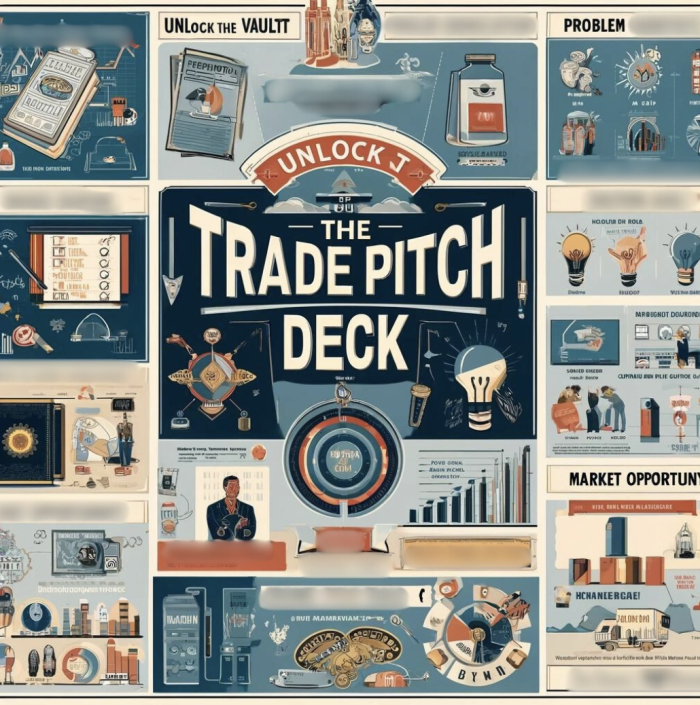
Last Words
Alright, we’ve covered a lot of ground, and by now, your trade pitch deck should be looking pretty sharp—sharp enough to cut through the noise and get those investors perking up in their plush seats. Remember, the key to a killer pitch isn’t just about dazzling with data; it’s about telling a story that resonates, solving a problem that matters, and presenting it all with a dash of style.
So, take this template, tweak it, twist it, make it your own. And when you’re standing there in the boardroom or wherever, delivering your pitch with all the passion you’ve got, remember this: You’ve got the vision and the plan to back it up—all that’s left is the execution. Go show them how you’re going to change the face of international trade.
Need a wingman? I’m just an email away. Let’s make sure your pitch isn’t just good, it’s the one they can’t stop talking about. Cheers to your success, and remember, in the world of trade, it’s not just about playing the game—it’s about changing it.
You got this!
But if you don’t got it:
Join hundreds of successful entrepreneurs who’ve transformed their pitch decks with my help.
Let me develop an investor ready deck by using my hands-off approach, which includes: market research, copy, design, financials, narrative and strategy.
One week turnaround time.
The least you will get is 10 actionable tips & strategies to own that next presentation, worth $599, for free.

If you want to really dive into the world of pitch decks, check out our complete collection of pitch deck templates.
Check out some of the essential 101 guides:
The Role of Emotional Storytelling in Pitch Decks
Why Color Psychology in Pitch Decks Matters More Than You Think
This is the ideal pitch deck length + exact slides Author: ViktorPitch Deck Expert. Ex…
How to Design a Visually Stunning Investor Pitch Deck + Template
This is the ideal pitch deck length + exact slides
This is the ideal pitch deck length + exact slides Author: ViktorPitch Deck Expert. Ex…
Mastering the Financial Projections Slide: Turning First Impressions into Lasting Opportunities
You’re convinced your startup is the next big thing, but somehow, your pitch keeps landing…
Creating an Impactful Traction Slide for Your Investor Pitch Deck: A Startup Guide
You’ve got the next unicorn startup brewing, but here’s the harsh reality: your traction slide…

